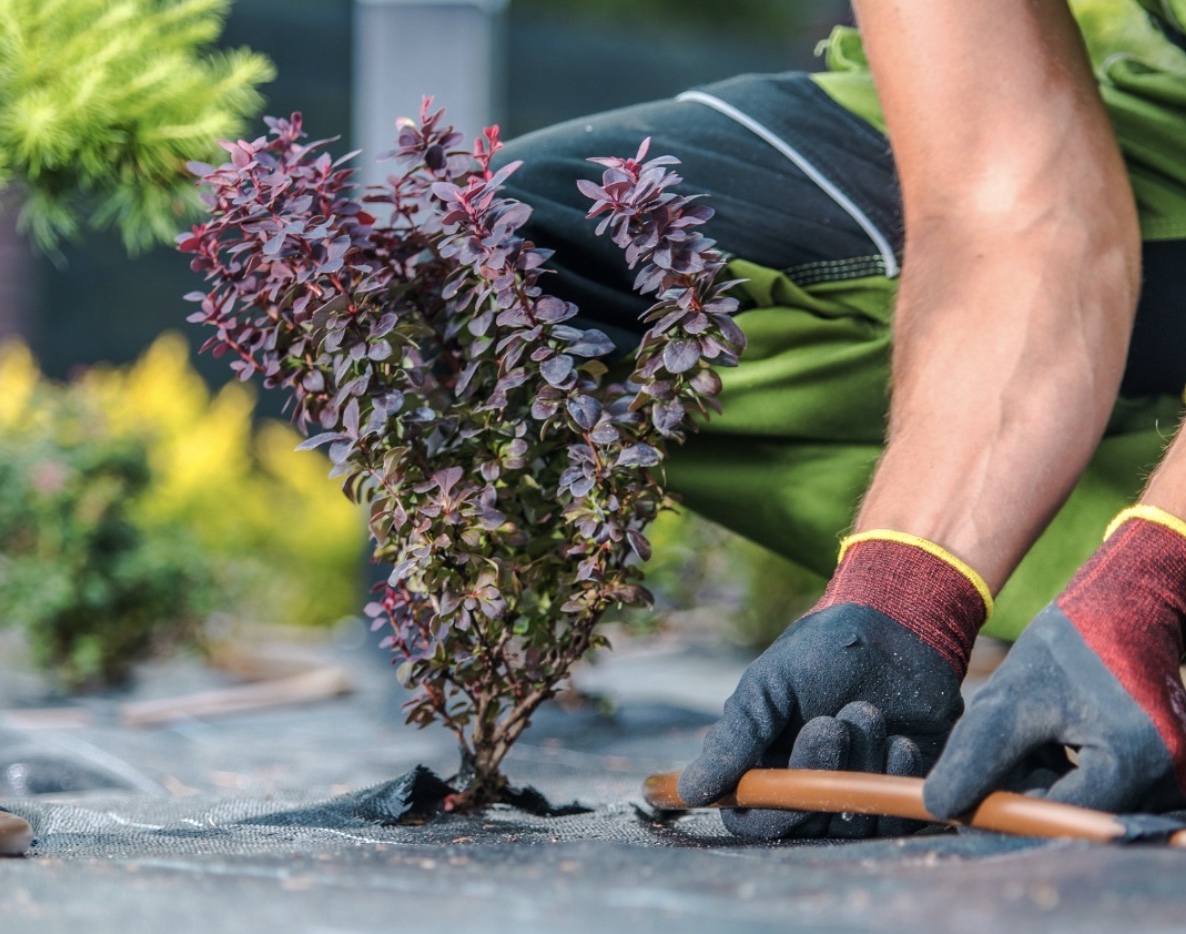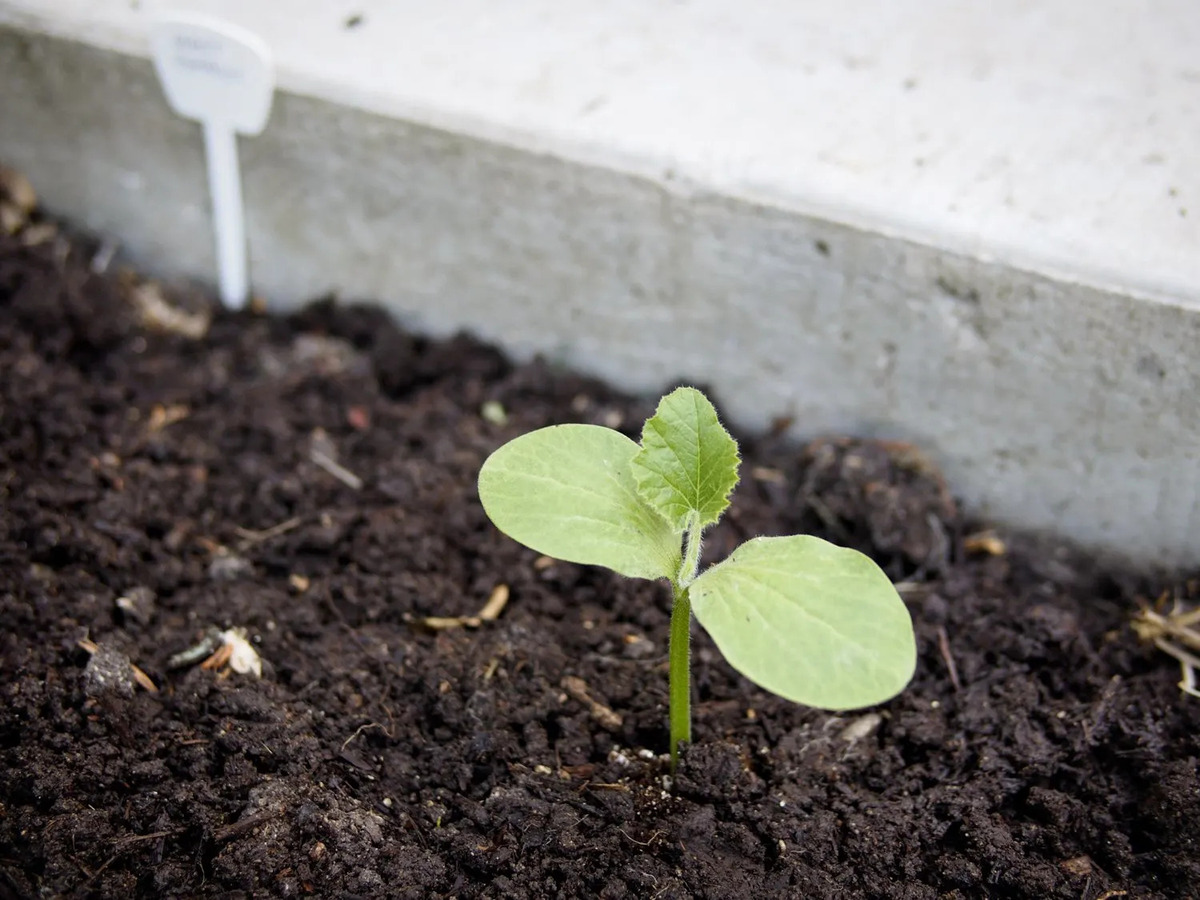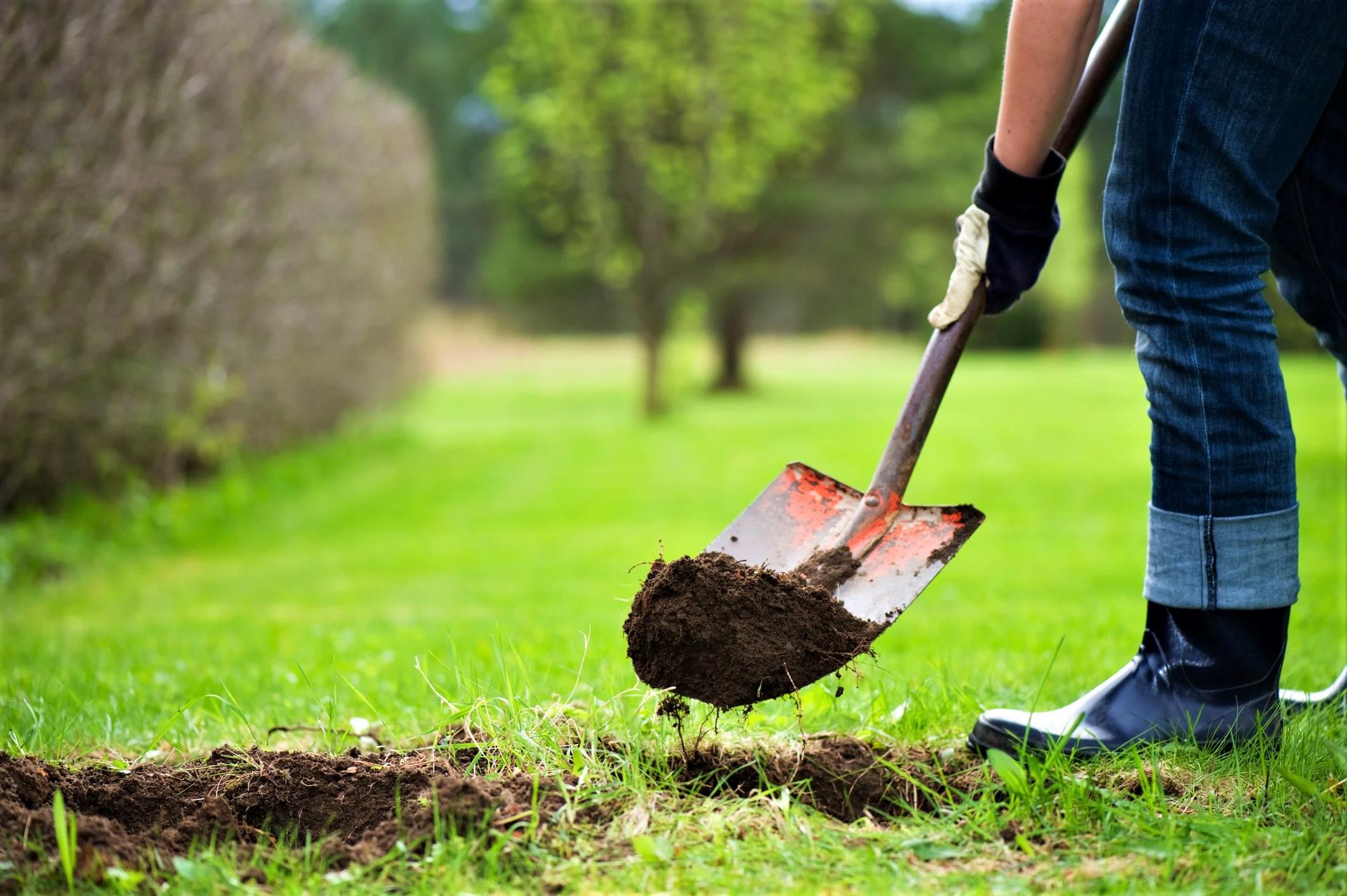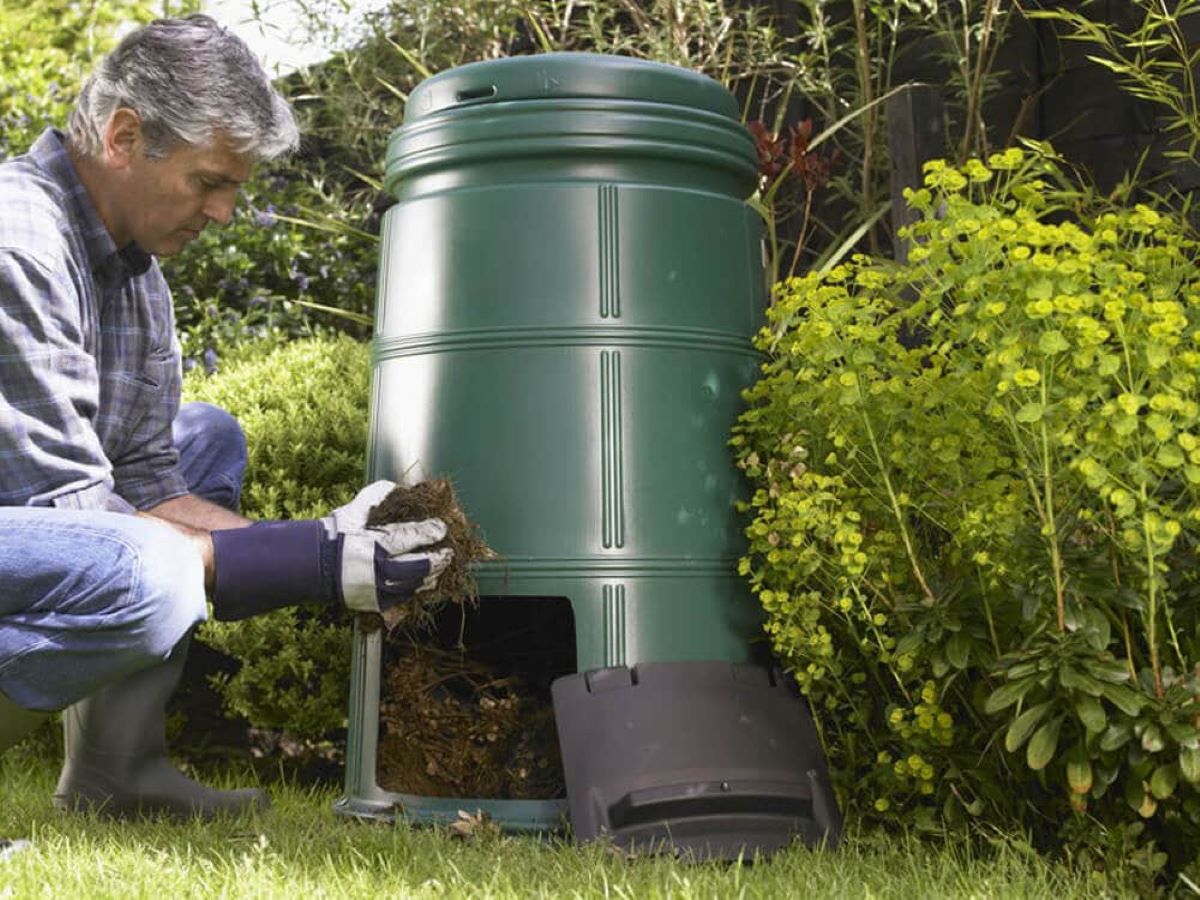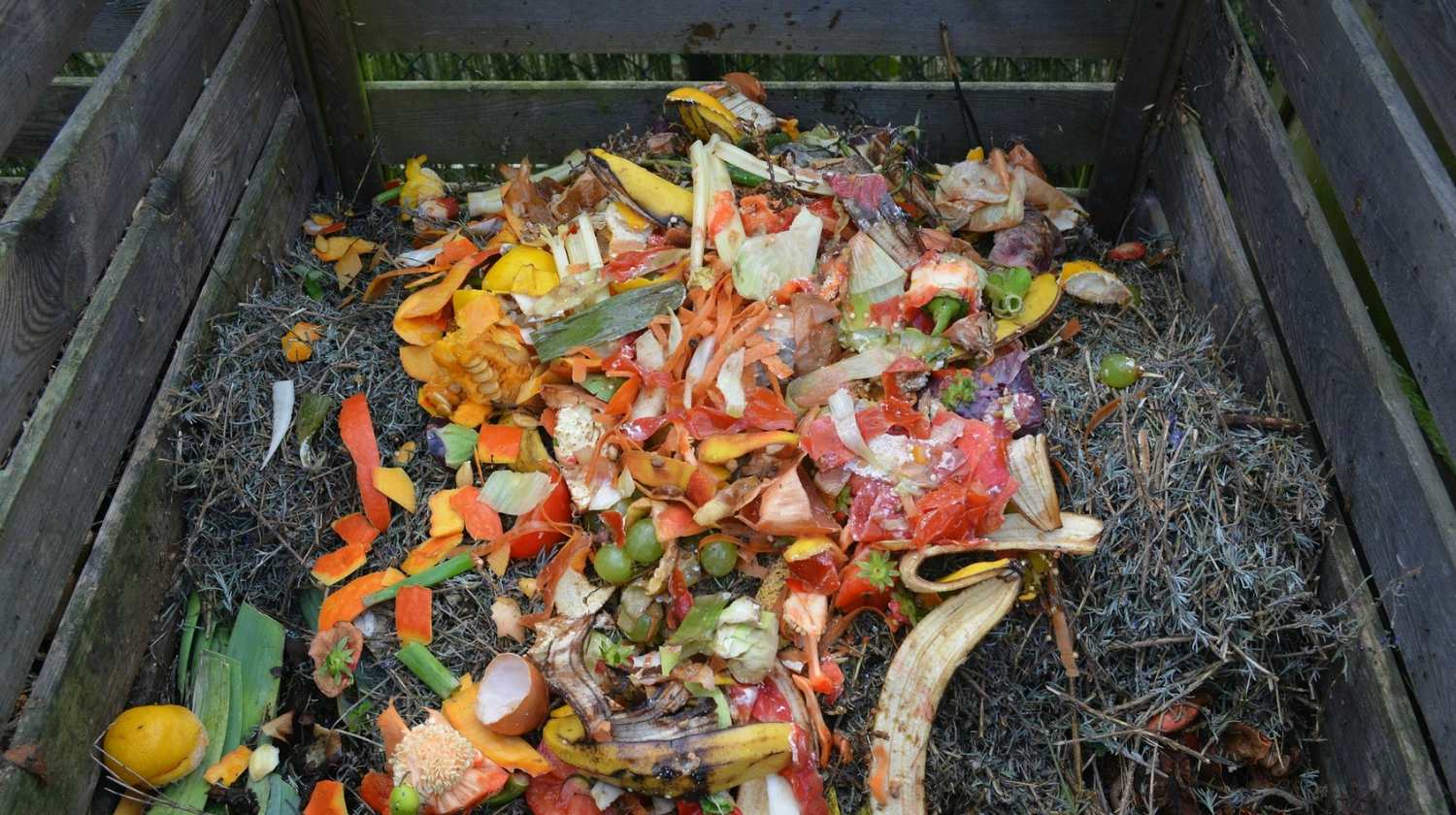Home>Gardening News and Trends>Latest News>What Can I Put Under My Deck To Prevent Weeds


Latest News
What Can I Put Under My Deck To Prevent Weeds
Modified: January 22, 2024
Looking for the latest news on preventing weeds under your deck? Discover effective solutions and tips to keep your deck weed-free and well-maintained.
(Many of the links in this article redirect to a specific reviewed product. Your purchase of these products through affiliate links helps to generate commission for Chicagolandgardening.com, at no extra cost. Learn more)
Table of Contents
- Introduction
- Factors contributing to weed growth under decks
- Importance of preventing weeds under decks
- Options for weed prevention under decks
- Landscape fabric or weed barrier
- Gravel or crushed stone
- Mulch
- Plastic sheeting or tarps
- Concrete or pavers
- Herbicides and weed killers
- Professional weed control services
- Considerations before choosing a weed prevention method
- Conclusion
Introduction
Having a deck in your backyard is a wonderful addition that allows you to enjoy outdoor living and entertain guests. However, one common issue that many homeowners face is the growth of weeds under their decks. These unwanted intruders not only detract from the overall appearance of your outdoor space but can also cause damage to the deck’s structure if left unchecked. So, what can you do to prevent weeds from taking over?
In this article, we will explore the various factors contributing to weed growth under decks, discuss the importance of preventing weeds, and provide you with some effective options to combat this problem. By understanding the underlying causes and taking the necessary measures, you can have a weed-free and well-maintained outdoor space that you can enjoy for years to come.
Factors contributing to weed growth under decks:
- Poor sunlight: Decks often create shady areas underneath, which can promote weed growth as many plants thrive in low light conditions.
- Moisture retention: Moisture can become trapped under the deck, creating a damp environment that weeds flourish in.
- Air circulation: Lack of proper air circulation under the deck can contribute to the growth of weeds.
- Seeds and spores: Weeds can sprout from airborne seeds or spores that find their way under the deck.
It is essential to address these contributing factors to prevent weeds from taking hold and spreading under your deck.
Importance of preventing weeds under decks:
While it may be easy to overlook or underestimate the significance of weeds under your deck, there are several reasons why it is important to prevent their growth:
- Visual appeal: Weeds can quickly transform a once pristine outdoor space into a messy and unkempt area. Maintaining weed-free surroundings contributes to the overall aesthetic appeal of your property.
- Structural integrity: Weeds can infiltrate the spaces between decking boards or grow through cracks, causing damage to the deck’s structure over time. By preventing weeds, you can protect the integrity and longevity of your deck.
- Maintenance reduction: Regularly removing weeds can consume a significant amount of time and effort. By preventing their growth in the first place, you can save yourself from the hassle of constant maintenance.
- Pest control: Weeds can attract pests like insects, rodents, and snakes, which can become a nuisance or pose health risks to you and your family.
Now that we understand why it is important to prevent weeds under decks, let’s explore some effective options for weed prevention.
Factors contributing to weed growth under decks
Understanding the factors that contribute to weed growth under decks is crucial for effectively preventing and addressing this issue. By addressing these underlying causes, you can create an environment that discourages weed growth and keeps your outdoor space looking its best.
1. Poor sunlight: One of the primary reasons why weeds thrive under decks is the lack of sunlight. The structure of the deck creates shade, preventing direct sunlight from reaching the ground. Weeds, particularly shade-tolerant varieties, can take advantage of these low-light conditions and establish a foothold. Additionally, the shade created by the deck can retain moisture, further promoting weed growth.
2. Moisture retention: The space under your deck can become a trap for moisture. Rainwater or irrigation runoff can pool under the deck, creating a damp environment that weeds love. This excess moisture provides optimal conditions for weed seeds to germinate and establish roots.
3. Lack of air circulation: Another contributing factor to weed growth under decks is limited air circulation. Without proper airflow, the area under your deck becomes stagnant, exacerbating the moisture issue. Adequate air circulation helps to dry out the soil, making it less hospitable for weeds to grow.
4. Seeds and spores: Weeds are tenacious plants that can reproduce from seeds or spores. These seeds can be transported by wind, animals, or even carried in on your clothing or shoes. Under your deck, these seeds can settle and find suitable conditions to sprout, leading to weed growth.
By understanding these factors, you can take proactive measures to prevent and mitigate weed growth under your deck. Implementing targeted strategies will help you create an environment that discourages weeds from taking hold.
Regular maintenance, such as sweeping or blowing debris from the deck surface, will prevent the accumulation of organic matter that can contribute to weed growth. Additionally, removing any existing weeds promptly and thoroughly will prevent them from spreading and establishing roots.
The next section will discuss the importance of preventing weeds under decks and explore effective options to keep your outdoor space weed-free.
Importance of preventing weeds under decks
While it may be tempting to overlook or dismiss the presence of weeds under your deck, it is crucial to understand the importance of preventing their growth. Weeds not only detract from the visual appeal of your outdoor space but can also cause significant damage if left unattended. Here are several reasons why preventing weeds under your deck is of utmost importance:
- Visual appeal: Weeds can quickly transform a once beautiful and well-maintained outdoor space into an eyesore. The sight of unsightly weeds poking through the gaps in your deck or sprouting in between cracks can significantly diminish the overall aesthetic of your backyard. By preventing weeds, you can ensure that your outdoor space remains visually inviting and enjoyable for you, your family, and your guests.
- Structural integrity: Weeds have the uncanny ability to invade and damage the infrastructure of your deck. They can grow through cracks, crevices, or gaps between the boards, taking advantage of any opening they can find. As they expand their roots and establish themselves, they can cause structural damage to your deck, compromising its stability and strength. By preventing weed growth, you can safeguard the structural integrity of your deck and prolong its lifespan.
- Maintenance reduction: Dealing with weeds can be a time-consuming and labor-intensive task. Regular weeding and removal become necessary to maintain a clean and tidy outdoor space. By preventing weeds from growing under your deck in the first place, you can significantly reduce the amount of time and effort spent on weed control. This allows you to spend more time enjoying your deck and less time battling with unwanted vegetation.
- Pest control: Weeds can attract pests, including insects, rodents, and other unwanted creatures. These pests can not only cause damage to your deck but can also become a nuisance or even pose health risks to you and your family. For example, some weeds can harbor ticks or fleas, which can carry diseases. By preventing weed growth under your deck, you can minimize the presence of pests and help keep your outdoor area safer and more comfortable.
- Environmental benefits: Preventing weeds under your deck not only benefits your immediate surroundings but also contributes to a healthier environment. Weeds compete with desirable plants for resources such as sunlight, water, and nutrients. By eliminating weed growth, you allow the plants you want to flourish and thrive, promoting biodiversity and the overall well-being of your garden ecosystem.
Considering these factors, it becomes evident that preventing weeds under your deck is vital for maintaining a visually appealing, structurally sound, and low-maintenance outdoor space. Now, let’s explore some effective options for preventing weeds under decks.
Options for weed prevention under decks
When it comes to preventing weeds under your deck, there are several effective options to consider. Each option has its advantages and suitability depending on your specific circumstances. Here are some options for weed prevention under decks:
- Landscape fabric or weed barrier: One common and straightforward method is to install landscape fabric or a weed barrier underneath your deck. These materials create a physical barrier that prevents weed seeds from reaching the soil. They allow water and nutrients to penetrate while blocking weed growth. However, it is important to secure the fabric or barrier properly to ensure its effectiveness.
- Gravel or crushed stone: Covering the area under your deck with a layer of gravel or crushed stone can serve as a weed deterrent. This option not only prevents weed growth but also improves drainage and discourages pests. Be sure to select a size of gravel or stone that is appropriate for preventing weed penetration.
- Mulch: Applying a layer of mulch under your deck can help prevent weeds from taking hold. Organic mulch, such as wood chips or bark, not only suppresses weed growth but also adds aesthetic value and helps retain moisture in the soil. Regular maintenance may be required to replenish the mulch as it breaks down over time.
- Plastic sheeting or tarps: Another option is to lay down plastic sheeting or tarps under your deck to create a barrier against weeds. These materials block sunlight and prevent weed seeds from germinating. However, they may not be as permeable to water and nutrients, which can affect the health of other plants in the area.
- Concrete or pavers: If you are looking for a more permanent solution, you can consider pouring concrete or installing pavers underneath your deck. This completely seals off the area, preventing any weed growth. However, it is essential to ensure proper drainage to avoid water pooling issues.
- Herbicides and weed killers: There are various herbicides and weed killers available on the market that can effectively control weed growth under your deck. However, it is important to carefully read and follow the instructions, considering the potential impact on the environment and surrounding plants.
- Professional weed control services: If the weed problem persists or if you prefer to leave it in the hands of experts, you can hire professional weed control services. They have the knowledge, experience, and tools to effectively treat and prevent weeds under your deck, tailored to your specific needs.
Before choosing a weed prevention method, consider factors such as your budget, personal preference, accessibility, and the specific conditions under your deck. It may also be a combination of methods that work best for your situation. Experiment and adapt to find the most effective solution that suits your needs.
By implementing an appropriate weed prevention method, you can ensure a weed-free environment under your deck and enjoy a beautiful, hassle-free outdoor space.
Landscape fabric or weed barrier
Landscape fabric or a weed barrier is a popular choice for preventing weed growth under decks. This method involves installing a physical barrier between the soil and the deck’s surface, effectively blocking weed seeds from germinating and taking hold. Here are some key points to consider:
Advantages:
- Weed suppression: The primary benefit of landscape fabric or a weed barrier is its ability to suppress weed growth. By creating a barrier, it prevents sunlight from reaching the soil, thus inhibiting weed seed germination and growth.
- Water and nutrient permeability: While the fabric or barrier blocks weed growth, it still allows water and nutrients to penetrate through to the soil. This ensures that your plants receive the necessary hydration and nourishment.
- Easy installation: Landscape fabric or weed barrier is relatively easy to install. It typically comes in rolls, which can be cut to fit the desired area. Simply lay the fabric or barrier over the soil, securing it with stakes or rocks to keep it in place.
- Cost-effective: Compared to some other methods, landscape fabric or weed barrier is a cost-effective solution for weed prevention. It is readily available at garden centers or home improvement stores and can be purchased in rolls at varying sizes.
Considerations:
- Proper installation: To ensure its effectiveness, landscape fabric or weed barrier must be properly installed. It’s crucial to remove any existing weeds and level the soil before laying down the fabric. Additionally, overlapping the edges and securing the fabric with stakes or rocks will prevent weeds from finding their way through any gaps.
- Longevity: While landscape fabric or weed barrier can provide long-term weed prevention, it may eventually degrade or become less effective over time. Factors such as exposure to sunlight, temperature fluctuations, and foot traffic can impact the longevity of the barrier. Regular inspection and possible replacement may be necessary to maintain optimal weed control.
- Compatibility: Consider the compatibility of landscape fabric or weed barrier with your deck’s construction. Ensure that the installation of the barrier does not interfere with the deck’s integrity or drainage systems. Adjustments may need to be made to accommodate the installation without compromising the deck’s structure.
While landscape fabric or a weed barrier can be an effective method for preventing weeds under decks, it is important to recognize that it may not offer complete weed control. Weed seeds can still be blown onto the fabric by wind or carried by animals, potentially leading to weed growth on top of the barrier. Regular inspection and maintenance are necessary to address any issues that arise.
Overall, landscape fabric or weed barrier is a practical and cost-effective option for preventing weed growth under your deck. By installing a reliable barrier and maintaining it properly, you can create a weed-free environment that enhances the beauty and longevity of your outdoor space.
Gravel or crushed stone
Another effective option for preventing weed growth under decks is the use of gravel or crushed stone. Covering the area underneath your deck with a layer of gravel or stones can serve as a natural barrier against weeds. Here are some key points to consider:
Advantages:
- Weed suppression: Gravel or crushed stone acts as a physical barrier, preventing weed seeds from making contact with the soil and germinating. This significantly reduces the chances of weed growth under your deck.
- Improved drainage: By using gravel or crushed stone, you can improve the drainage in the area beneath your deck. These porous materials allow rainwater to flow through, preventing puddles or water accumulation and reducing the moisture levels that weeds thrive on.
- Pest deterrence: The use of gravel or stone can also discourage pests such as rodents, snakes, and insects from inhabiting the area under your deck. Unlike organic mulches, which can provide shelter for pests, gravel or crushed stone creates an inhospitable environment for them.
- Low maintenance: Once installed, gravel or crushed stone requires minimal maintenance. Unlike organic mulches that decompose over time, gravel and stone will not need frequent replenishing. Occasional raking or leveling may be necessary to maintain an even surface, but overall, they are hassle-free options.
Considerations:
- Proper installation: To effectively prevent weeds, it is essential to prepare the area properly before laying down the gravel or crushed stone. Remove any existing vegetation and ensure the soil is level. It is recommended to lay down a landscaping fabric or weed barrier beneath the gravel or stone to provide an additional layer of protection and prevent weeds from growing through.
- Appropriate size and depth: Choosing the right size and depth of gravel or crushed stone is crucial. Opt for a size that is large enough to discourage weed penetration but small enough to provide a stable surface. A depth of 2-3 inches is generally sufficient to prevent weed growth.
- Compatibility: Consider the compatibility of gravel or crushed stone with your deck’s construction and design. Ensure that the installation of these materials does not interfere with the integrity of the deck or its drainage systems. It’s important to maintain proper water flow and avoid any potential damage to the deck structure.
- Aesthetics: While gravel or crushed stone can be a practical solution for weed prevention, consider the aesthetic appeal it brings to your outdoor space. Choose a color and texture that complements your deck and overall landscaping, ensuring a cohesive and visually pleasing design.
Gravel or crushed stone can be a cost-effective and durable option for preventing weeds under your deck. By providing a physical barrier and improving drainage, this method not only controls weeds but also enhances the overall functionality and appearance of your outdoor space. Regular maintenance, such as leveling and inspecting for possible weed growth, will help ensure its long-term effectiveness.
Mulch
Mulch is a versatile and widely-used option for preventing weed growth under decks. It offers several benefits beyond weed suppression, making it a popular choice for many homeowners. Here’s what you need to know about using mulch for weed prevention:
Advantages:
- Weed suppression: Mulch acts as a protective layer, smothering weeds and preventing them from accessing sunlight. This impedes weed growth by reducing their ability to sprout and take hold under your deck.
- Moisture retention: Mulch helps to retain moisture in the soil, reducing water evaporation and preventing the growth of weed seeds. This is particularly beneficial in dry or arid climates where maintaining adequate soil moisture can be challenging.
- Soil temperature moderation: Mulch provides insulation, helping to regulate the temperature of the soil beneath your deck. This can prevent extreme heat or cold from reaching the soil, creating a more favorable environment for your desired plants while also slowing down weed growth.
- Organic matter enrichment: As mulch breaks down over time, it adds organic matter to the soil, improving its fertility and overall health. This can promote the growth of desirable plants while suppressing the growth of weeds.
- Aesthetics: Mulch comes in various colors and textures, allowing you to choose options that complement your deck and landscaping design. It can provide a neat and visually appealing appearance to the area beneath your deck.
Considerations:
- Selection of mulch type: There are several types of mulch available, including wood chips, bark, compost, and shredded leaves. Consider factors such as availability, cost, durability, and aesthetic appeal when selecting the type of mulch that best suits your needs.
- Depth and application: Apply a layer of mulch around 2-3 inches thick for effective weed prevention. Be mindful not to over-mulch, as excessive depth can prevent water and air from reaching the soil. Apply mulch evenly, covering the entire area under your deck but keeping it away from direct contact with the deck’s structure.
- Maintenance: Mulch will break down over time and may need replenishing to maintain its weed-suppressing capabilities. Regularly check for signs of weed growth and add new mulch as necessary. Also, be mindful of any potential issues such as pests or diseases that may arise from using certain types of mulch.
- Compatibility: Ensure that the use of mulch does not interfere with the drainage of your deck or cause any damage to its structure. Proper water flow is essential to prevent water pooling or moisture problems that can encourage weed growth or compromise the integrity of the deck’s foundation.
Mulch offers both functional and aesthetic benefits for preventing weed growth under decks. By creating a barrier against weeds, retaining moisture, moderating soil temperature, and enriching the soil, mulch can contribute to a healthier and more visually appealing outdoor space. Regular maintenance and diligent weed monitoring will help ensure its effectiveness over time.
Plastic sheeting or tarps
Using plastic sheeting or tarps is an option for preventing weed growth under decks that offers convenience and effectiveness. This method involves the installation of a synthetic barrier that blocks weed growth by denying sunlight and access to the soil. Here’s what you need to know about using plastic sheeting or tarps:
Advantages:
- Weed suppression: Plastic sheeting or tarps effectively inhibit weed growth by creating a physical barrier that prevents sunlight from reaching the soil. This denies weed seeds the light they need to germinate, significantly reducing weed growth underneath your deck.
- Durability: Plastic sheeting or tarps are durable and can withstand harsh weather conditions. They are resistant to degradation from water, UV rays, and temperature fluctuations, ensuring long-lasting weed prevention.
- Easy installation: Installing plastic sheeting or tarps is a relatively simple process. Lay the material down over the area beneath your deck and secure the edges with stakes or rocks to keep it in place. This makes it a convenient option for homeowners looking for a quick solution.
- Accessibility: Plastic sheeting or tarps are readily available at most home improvement stores or garden centers. They come in various sizes and thicknesses, allowing you to choose the most suitable option for your specific needs.
Considerations:
- Proper installation: To ensure the effectiveness of plastic sheeting or tarps, proper installation is crucial. Clear the area of any existing weeds or vegetation and level the soil before laying down the barrier. Overlap the edges and secure them properly to prevent weed seeds from finding their way through any gaps.
- Drainage considerations: Since plastic sheeting or tarps create a non-permeable barrier, they may impede water drainage in the area beneath your deck. To prevent water accumulation and potential damage, create drainage channels or perforate the barrier to allow water to escape.
- Longevity: Although plastic sheeting or tarps are durable, they may deteriorate over time due to UV exposure or physical wear and tear. Regular inspection and maintenance are necessary to address any signs of degradation or damage and ensure ongoing effectiveness.
- Aesthetics: Plastic sheeting or tarps may not provide the most visually appealing option for weed prevention. They lack the natural look of other methods like mulch or gravel. Consider incorporating decorative elements, such as potted plants or attractive coverings, to mask the appearance of the plastic barrier.
Plastic sheeting or tarps offer a convenient and effective solution for preventing weed growth under decks. By blocking sunlight and creating a physical barrier, they can significantly reduce the need for ongoing weed maintenance. However, it’s important to address drainage concerns and monitor the condition of the barrier regularly to ensure its durability and effectiveness.
Concrete or pavers
For a more permanent and aesthetically pleasing solution, concrete or pavers can be used to prevent weed growth under decks. Creating a solid surface effectively eliminates the space for weeds to take hold. Here’s what you need to know about using concrete or pavers:
Advantages:
- Weed prevention: Concrete or pavers form a solid, impenetrable surface that prevents weeds from growing. Without any gaps or spaces for weeds to access the soil, this method guarantees long-term weed control and reduces the need for ongoing maintenance.
- Durability: Concrete and pavers are highly durable materials that can withstand heavy foot traffic, extreme weather conditions, and UV exposure. Once installed, they provide a stable and long-lasting solution for preventing weeds under your deck.
- Clean and neat appearance: Concrete or paved surfaces create a clean and visually appealing look for the area beneath your deck. They provide a cohesive and well-defined space that complements the overall design of your outdoor area.
- Low maintenance: Once installed, concrete or pavers require minimal maintenance for weed control. Occasional sweeping or rinsing is usually sufficient to keep the surface clean and free from debris, making it a convenient option for homeowners.
Considerations:
- Installation complexity: The installation of concrete or pavers can be more involved and may require professional assistance, depending on your level of DIY expertise. Ensure that the surface is properly leveled and prepared before pouring or laying the material to ensure long-term durability and weed prevention.
- Drainage considerations: Proper drainage is crucial when using concrete or paved surfaces. Ensure that the structure allows water to flow away from your house and deck, preventing any water accumulation that can lead to moisture issues or damage.
- Environmental impact: Consider the environmental impact of using concrete or pavers, as they can contribute to increased heat absorption and reduced water infiltration compared to permeable surfaces. Incorporating green spaces or permeable areas nearby can help mitigate these effects.
- Cost: The cost of using concrete or pavers as a weed prevention method can be higher compared to other options. Consider your budget and long-term investment when deciding on this solution.
Concrete or pavers offer a permanent and visually appealing solution for preventing weed growth under decks. Their durability and low-maintenance nature make them an attractive choice for homeowners seeking a long-term weed control solution. Proper installation and consideration of drainage are essential to ensure the effectiveness and longevity of the surface. With proper planning and attention to detail, concrete or pavers can provide a weed-free and beautiful under-deck space for years to come.
Herbicides and weed killers
Herbicides and weed killers can be effective tools for preventing weed growth under decks. These chemical treatments target and eliminate weeds, providing long-lasting control. Here’s what you need to know about using herbicides and weed killers:
Advantages:
- Precision targeting: Herbicides and weed killers offer precise targeting of weeds, effectively killing them at the source. They can be applied directly to existing weeds or used as a preventive measure to inhibit weed seed germination and growth.
- Systemic action: Many herbicides are systemic, meaning they are absorbed by the weed’s foliage and spread to the root system, effectively eliminating the entire plant. This helps prevent weed regrowth and provides longer-lasting control.
- Time-saving: Herbicides and weed killers offer a time-saving solution for preventing and controlling weed growth. Once applied, they require minimal ongoing maintenance, providing hands-off weed control for an extended period.
- Flexibility: Herbicides and weed killers are available in various forms, including spray, granules, and concentrated solutions. They can be selected based on the specific weed problems you are facing and the level of control required.
Considerations:
- Environmental impact: It is important to consider the potential environmental impact of herbicides and weed killers. Some products may have specific application guidelines to minimize harm to beneficial plants, animals, and the environment. Always follow the instructions and use them responsibly.
- Timing and application: The effectiveness of herbicides and weed killers can depend on the timing of application. Applying them when weeds are actively growing and are in their early stages is generally recommended for optimal control. Follow the instructions on the product label regarding timing and application rates for best results.
- Residual effects: Some herbicides can have residual effects, meaning they can remain in the soil and affect the growth of desirable plants. Take caution when using herbicides in areas where you plan to plant or cultivate other vegetation.
- Personal safety: As with any chemical treatment, it is important to use herbicides and weed killers safely. Wear appropriate protective clothing, follow the label instructions, and keep children and pets away from treated areas until it is safe.
Herbicides and weed killers offer an efficient and targeted approach to preventing and controlling weeds under decks. However, it is important to carefully choose the appropriate product, follow safety measures, and consider the potential environmental impact. Consulting with a professional or seeking advice from a local garden center can provide insights and guidance on the most suitable herbicides for your specific needs.
Professional weed control services
Engaging the services of professional weed control can be a convenient and effective option for preventing weed growth under decks. These experts have the knowledge, experience, and specialized tools necessary to tackle stubborn weed problems. Here’s what you need to know about professional weed control services:
Advantages:
- Expertise and experience: Professional weed control services bring specialized knowledge and experience in identifying, targeting, and eliminating various types of weeds. They can assess the specific conditions under your deck and recommend the most appropriate strategies and treatments for effective weed prevention.
- Efficient and thorough: Professionals have access to specialized equipment and techniques that ensure efficient and thorough weed control. They can apply targeted treatments, such as herbicides or pre-emergent solutions, to prevent weed growth and minimize the need for ongoing maintenance.
- Customized approach: Professional weed control services can tailor their approach based on your specific needs. They consider factors such as the type of weeds present, the size of the area, and any environmental concerns to develop a customized weed control plan that addresses your unique situation.
- Time-saving: By entrusting your weed prevention efforts to professionals, you save time and effort that would otherwise be spent on manual weeding and maintenance. This allows you to focus on other aspects of your outdoor space while enjoying the peace of mind that comes with expert weed control.
Considerations:
- Cost: Professional weed control services typically come at a cost. Consider your budget and weigh it against the convenience and expertise that professionals bring. Obtain multiple quotes and compare services to find the option that best fits your needs.
- Performance guarantee: Inquire about performance guarantees or warranties offered by professional weed control services. Knowing that they stand behind their work can provide added reassurance of the effectiveness of their treatments.
- Continued maintenance: While professional weed control services can provide long-lasting results, ongoing maintenance may still be required. Discuss the recommended maintenance plan with the professionals and clarify any expectations regarding follow-up treatments or monitoring of weed growth.
- Environmental impact: It is important to discuss any environmental concerns with the professional weed control service you choose. Inquire about their practices and use of environmentally friendly products or integrated pest management approaches to minimize the impact on beneficial plants, animals, and the ecosystem.
Professional weed control services offer expertise and convenience in effectively preventing and controlling weed growth under decks. While there is a cost involved, the customized approach, time savings, and thorough results they provide can outweigh the investment for many homeowners. Research and choose a reputable service provider who aligns with your needs and environmental considerations to ensure the best outcome for your weed control efforts.
Considerations before choosing a weed prevention method
Before choosing a weed prevention method for your deck, there are several important considerations to keep in mind. Every situation is unique, so it’s essential to evaluate these factors to determine the most suitable approach for your specific needs. Here are some key considerations:
1. Budget: Consider your budgetary constraints when selecting a weed prevention method. Some options, like professional weed control services or installing concrete or pavers, may require a higher investment compared to other methods such as using mulch or gravel. Determine how much you are willing to spend and choose a method that aligns with your financial capacity.
2. Maintenance requirements: Evaluate the level of ongoing maintenance you are willing to undertake. Some methods, such as landscape fabric or plastic sheeting, require minimal maintenance once installed, while others, like mulch or gravel, may need periodic replenishment or leveling. Consider your time availability and commitment to maintaining your deck’s weed prevention efforts.
3. Aesthetic preferences: Think about the visual appeal you desire for the area underneath your deck. Options like gravel or crushed stone offer a natural and rugged look, while using concrete or pavers can provide a polished and clean appearance. Consider how each method will complement the overall design of your outdoor space.
4. Environmental impact: Take into account the environmental impact of the weed prevention method you choose. Some chemical herbicides may have negative effects on the environment, while options like landscape fabric, mulch, or organic weed killers offer more environmentally-friendly alternatives. Choose a method that aligns with your values and minimizes harm to the ecosystem.
5. Weed type and severity: Assess the type and severity of weed growth under your deck. Some methods, like using herbicides or professional services, may be more effective for stubborn or widespread weed infestations, while others, such as mulching or gravel, may suffice for lighter weed problems. Tailor your approach to the specific weed issues you face.
6. Compatibility with the deck structure: Ensure that the weed prevention method you choose is compatible with your deck’s construction and design. Consider factors such as drainage requirements, the need for air circulation, and effects on the overall integrity of the deck. Verify that the chosen method will not cause any damage or compromise the stability of the deck.
7. Personal safety: If you opt for chemical herbicides or weed killers, prioritize your safety and that of others using the outdoor space. Follow the instructions on the product labels, use protective clothing, and keep children and pets away from treated areas until it is safe. Take precautions to prevent any potential harm.
By carefully considering these factors, you can select the most appropriate weed prevention method that aligns with your budget, maintenance capabilities, aesthetic preferences, and environmental concerns. Always remember to choose a method that effectively addresses the specific weed issues under your deck and contributes to the long-term health and beauty of your outdoor space.
Conclusion
Preventing weed growth under decks is vital for maintaining a clean, visually appealing, and structurally sound outdoor space. Weeds not only detract from the overall beauty of your deck but can also cause damage if left unchecked. By considering the factors contributing to weed growth, understanding the importance of prevention, and exploring various options, you can find the most effective method for your specific needs.
Each weed prevention method has its advantages and considerations. Landscape fabric or weed barrier offers a simple and cost-effective solution, while gravel or crushed stone provides effective weed suppression and improved drainage. Mulch offers aesthetic appeal and enriches the soil, while using plastic sheeting or tarps provides a durable and convenient barrier. Concrete or pavers provide a permanent and visually pleasing option, while herbicides and professional weed control services offer expert guidance and long-lasting results.
Before choosing a weed prevention method, consider factors such as your budget, maintenance capabilities, aesthetic preferences, environmental impact, weed type and severity, compatibility with the deck structure, and personal safety considerations. By evaluating these factors, you can choose the most suitable method for your unique situation.
Remember that preventing weeds under your deck is an ongoing effort. Regular maintenance, monitoring, and appropriate follow-up actions are essential to ensure long-term weed control. Whether you choose to implement one method or combine several approaches, consistent attention is key to maintaining a weed-free and beautiful outdoor space.
By taking proactive measures to prevent weed growth under your deck, you can create an environment that enhances the beauty, longevity, and enjoyment of your outdoor living area. Invest the time and effort into weed prevention, and you will reap the rewards of an inviting, well-maintained, and weed-free deck for years to come.
